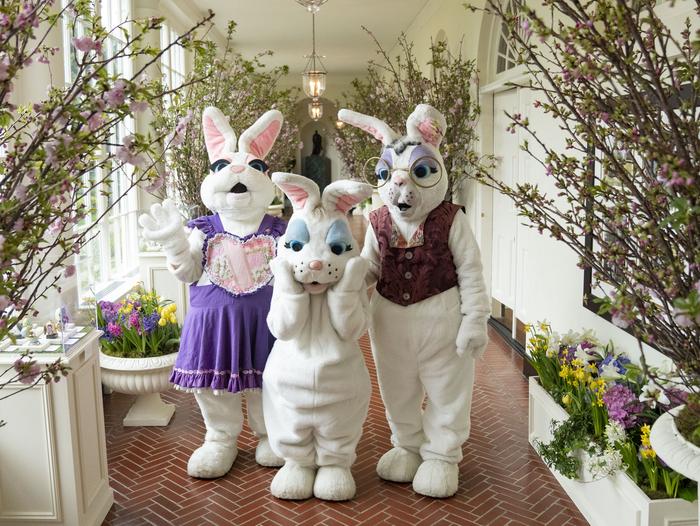What does a rabbit that lays eggs have to do with the most important day on the Christian calendar?
We don’t have an answer for that (though Time magazine does), but we do have answers to some other questions that surround this holiday. With Easter this weekend and Orthodox Easter on April 16, The NAU Review asked religious studies faculty about the Christian holy day and its relationship to the Jewish holy day of Passover. Jason Beduhn, a professor in the Department of Comparative Cultural Studies and a Guggenheim and National Humanities Center Fellow, studies ancient Christianity and is part of a project to edit and translate an ancient Coptic Manichaean manuscript. Carli Anderson, an assistant teaching professor of the comparative study of religions and humanities, studies contested religious spaces and how contemporary biblical texts construct those spaces for different communities.
Why is Easter a different day each year?
JB: Early Christians lived in many countries with different calendars, so it wasn’t practical to fix the date of Easter on just one calendar, such as the Roman one on which our modern calendar is based. Instead, it had to be calculated in a calendar-neutral way, using the Spring Equinox, then the first full moon after that, then the first Sunday after that. Since the phases of the moon vary in relation to dates on our solar calendar, the date of Easter varies accordingly from year to year. While in theory this calculation should have kept Easter close to Passover in timing, differences between the Roman and Jewish calendars over time have produced what we now see: sometimes they fall together, and sometimes they fall apart.
What is Passover, and is it connected to Easter?
JB: Passover is the Jewish holy day commemorating the Exodus from Egypt, the freeing of the ancestors of the Jewish people from slavery in Egypt. It is connected to Easter because both Jesus and his disciples were Jews and celebrated this holy day just before Jesus was arrested and executed by the Romans. The commemoration of the death and resurrection of Jesus by Christians in this way is connected by timing to Passover since those events occurred right after Passover. Early Christians (many of whom were Jewish believers in Jesus) continued to observe both holy days together and called the combined annual observance ‘Passover’ (Pesach). The name ‘Easter’ was introduced later, when subsequent Christian leaders who did not come from Jewish backgrounds advocated for independently determining when to observe the holy day rather than continuing to coordinate with Jewish leaders on the timing of both. That was when a new formula for calculating when to observe Easter was introduced.
What is Orthodox Easter, and how is it different from the Easter celebrated by the rest of the Christian world?
CA: Regarding Orthodox Easter, it celebrates the death and resurrection of Jesus in many of the same ways other denominations of the Christian world do. It usually is celebrated on a different date from the Catholic and Protestant calendar because Orthodox Christians still utilize the Julian (rather than Gregorian) calendar to mark the holiday. It is not a fixed “date” for Orthodox Christians either, since Orthodox Christianity also still uses the date of the Jewish celebration of Passover as a framework. The full moon is taken into consideration since the Jewish religious calendar is based on lunar cycles and thus Passover will always fall on a full moon. Orthodox Easter will be April 16 this year, just a week later than most other Christian denominations, though it can be up to almost a month later, depending on the year.
This difference of date is one of many differences which evolve out of the “Great Schism,” which split the Christian world into a kind of “east and west” (“Orthodox” and “Catholic”) structure around 1054 CE. (Protestant Christianity came about 500 years later.)
One unique aspect of Orthodox Easter is the Celebration of the Holy Fire, which takes place in Jerusalem at the Church of the Holy Sepulchre. Each Easter, Greek, Armenian, Russian, Syrian, Coptic and other Orthodox Christianities take part in this more than 1,000-year-old tradition.
A miraculous flame is said to appear in the Chapel of the Tomb at midday on the Saturday before Orthodox Easter. The Greek and Armenian Church Patriarchs enter the Tomb and light candles from this special fire and begin to distribute the flame, candle to candle, to the crowds of Christians in and around the church, all waiting with their unlit candles. Celebrants light their candles from the sacred flame to anticipate the joy of the coming Easter morning. The Holy Fire is even sent abroad to Christian communities all over the world that have representatives there at the celebration. Planes are chartered and waiting at the airport in Tel Aviv to quickly take some of the fire back to their churches in Russia, Greece, Poland and Ukraine for the Saturday night “Easter Vigil.”
Top photo: Easter bunnies at the White House Easter egg roll, National Parks Service



